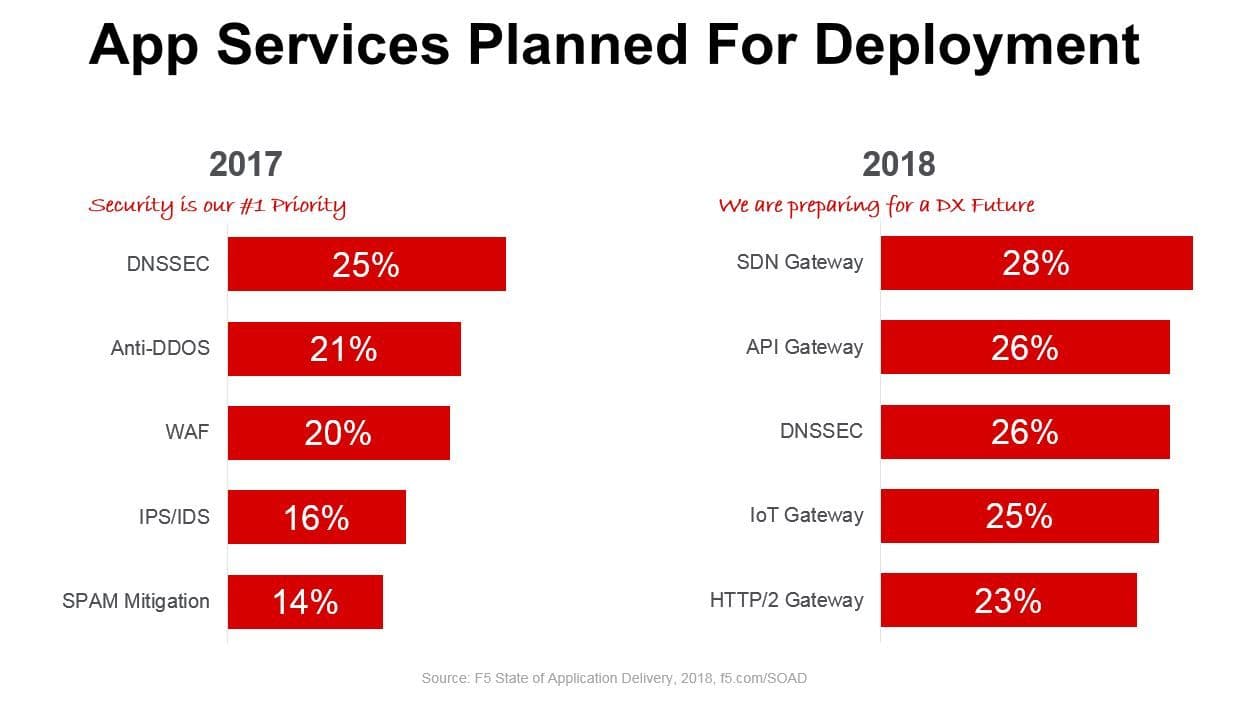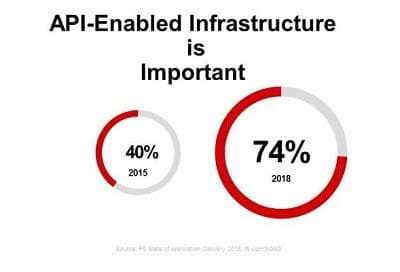In 2015, we recognized that the importance of the application services portion of the IT market was accelerating but the breadth of application services in the market and their necessity in the successful implementation of any new application was not yet widely understood. To explore our questions, we asked IT professionals to tell us how they were deploying application services considering future strategic trends.
As a result, the first report in the industry on application services, was created--The State of Application Delivery. Since then, each year F5 has surveyed customers across the globe on the application delivery, cloud services, and IT trends that they’re seeing as part of their day to day business. Now with our fourth annual report just published, it seems an appropriate time to look back and share how the market has evolved and what we have learned.
Among all the interesting data points across our research, one theme really bubbles to the top: The mix of application services planned for deployment from our first survey to today tells us that IT organizations are in the middle of a profound transition of not only architectures and applications, but of their charter within the organization.
Let’s look at what this means through the lens of four years of surveying the application services landscape:
Application services are pervasive globally and they are becoming more important.
In our second year, we expanded the scope of the research to a global audience and now the survey is implemented in nine languages, across every region. No matter the region (Asia Pacific, EMEA and the Americas) or language, the results have tracked the same: Network firewalls, anti-virus, SSL VPN, load balancing and SPAM mitigation application services have consistently been the most widely deployed application services both globally and within each region. The types of application services continue to rise steadily. On average, organizations report that they have 16 application services deployed today, up from 14 in 2017 and 11 in 2016.
The importance of security services continues to rise.
Four years ago, with an American English-speaking audience we were able to have a little fun and ask the respondents to complete the following sentence “I would rather eat worms than deploy an application without____.” At that time, 40% reported they couldn’t do without availability services – nothing else mattered if the app wasn’t up and performing. As we went global, the question changed- “the worst thing I could do is deploy an application without_____.” And the answer has shifted, too: It’s been a race to the finish, but last year security moved ahead of availability. And this year, that lead was extended with 43% of respondents declaring the worst thing they could do was deploy an app without security services. Availability still garnered a respectable 33%, the same as in 2017, and 1% higher than in 2016.
IT organizations have taken a seat at the digital table
Back in 2015 the application services planned for deployment were a traditional mix of security, availability and identity services for on-premises applications. As the era of high profile breaches began so did an all-out effort by the respondents to stay out of the headlines. In 2017 the top five services planned for deployment were all security services. While security services remain critical, today we see IT has a seat at the digital table – participating and supporting transformation efforts. Gateway application services, which bridge the gaps between existing and emerging protocols and technology, were the top services to be deployed in 2018. These gateways are bridging SDN, IoT and APIs, and increasingly the applications these services support are off-premises, in the public cloud. The percentage of respondents who have over 25% of their applications in cloud has steadily risen from 34% in 2016 to 44% in 2018.

API-enabled infrastructure paves the way for automation and orchestration
In 2015, we believed that automation would have a pivotal role to play in scaling IT operations to support cloud-ready mobile applications - but the pace of growth surpassed our expectations. Automation relies in part on API-enabled infrastructure across compute, network and storage domains. In our first survey, 40% of the respondents told us an API-enabled infrastructure was somewhat or very important. Fast forward to today and nearly 3-out-of-4 (74%) reported the importance of an API-enabled infrastructure.
We also learned some technologies need to mature and evolve before they find their trajectory. SDN was a hot topic in 2015 and while still relevant today – it has not produced the phenomenal trajectory we see in API-enabled infrastructure or public cloud adoption.

Today, the respondents to the State of Application Delivery are embracing cloud and automation and orchestration to have the scale, agility and speed they need for digital transformation. They are adjusting their security strategies to focus on the application and prepare for the reality of a multi-cloud world. And they are expanding and enriching their application services deployments to prepare for new innovative applications.
Our sincere thanks to everyone who has taken the time to tell us about their deployments and use of application services. It’s been a great four years and we are looking forward to the future – where we suspect digital transformation, containers, IoT, artificial intelligence and machine learning and will be transforming the landscape of application services.
Download your own copy of our 2018 State of Application Delivery report and share your thoughts on Twitter by tagging @F5Networks and/or the hashtag #SOAD18.
About the Author

Related Blog Posts

AppViewX + F5: Automating and orchestrating app delivery
As an F5 ADSP Select partner, AppViewX works with F5 to deliver a centralized orchestration solution to manage app services across distributed environments.

Build a quantum-safe backbone for AI with F5 and NetApp
By deploying F5 and NetApp solutions, enterprises can meet the demands of AI workloads, while preparing for a quantum future.

F5 ADSP Partner Program streamlines adoption of F5 platform
The new F5 ADSP Partner Program creates a dynamic ecosystem that drives growth and success for our partners and customers.
F5 NGINX Gateway Fabric is a certified solution for Red Hat OpenShift
F5 collaborates with Red Hat to deliver a solution that combines the high-performance app delivery of F5 NGINX with Red Hat OpenShift’s enterprise Kubernetes capabilities.
F5 Silverline Mitigates Record-Breaking DDoS Attacks
Malicious attacks are increasing in scale and complexity, threatening to overwhelm and breach the internal resources of businesses globally. Often, these attacks combine high-volume traffic with stealthy, low-and-slow, application-targeted attack techniques, powered by either automated botnets or human-driven tools.
Phishing Attacks Soar 220% During COVID-19 Peak as Cybercriminal Opportunism Intensifies
David Warburton, author of the F5 Labs 2020 Phishing and Fraud Report, describes how fraudsters are adapting to the pandemic and maps out the trends ahead in this video, with summary comments.
